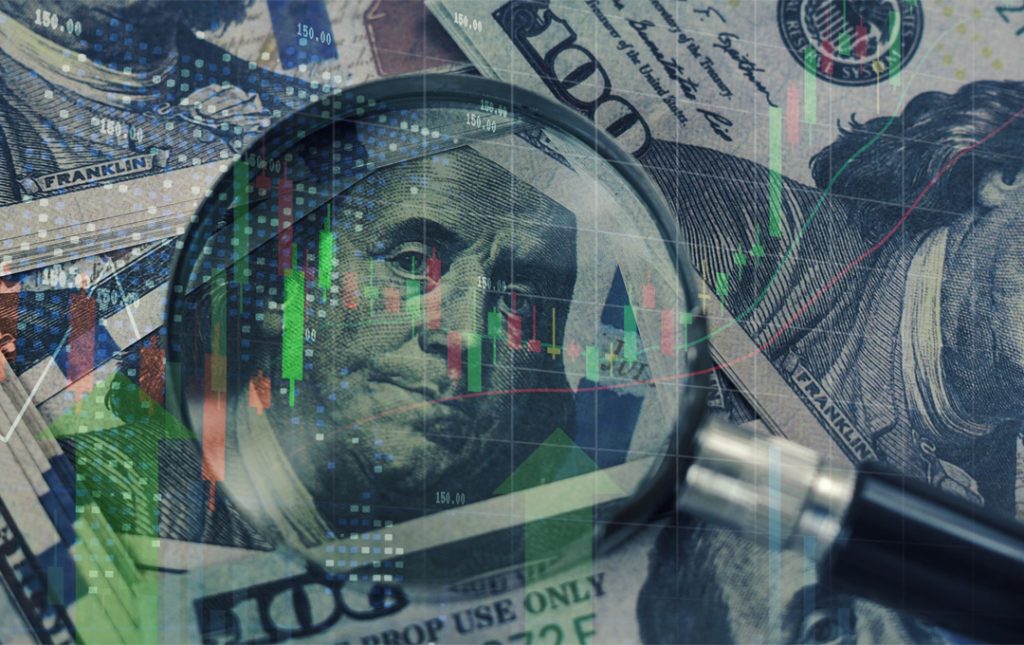Key Points:
- Euro falls ahead of ECB meeting, rate cut expected
- China’s fiscal stimulus briefing disappoints, yuan slides
- Sterling edges lower against the dollar as the Bank of England takes a cautious approach
- Bitcoin and ether reach two-week highs as risk assets rebound
The U.S. dollar extended its bullish streak, hitting a 10-week high on Monday, buoyed by expectations of moderate interest rate cuts by the Federal Reserve. Thin trading volumes, due to holidays in Japan and Canada, allowed the dollar to maintain its upward momentum in an environment where global economic uncertainty continues to weigh on sentiment.
Dollar Strength Amid Fed Policy Outlook
The dollar index (DXY), which measures the greenback against a basket of six major currencies, rose to 103.36, its highest level since August 8. U.S. economic data, which suggests a modestly slowing economy, continues to align with market bets on gradual interest rate cuts.
The Federal Reserve has already implemented a 50 basis-point rate cut last month, and markets are now pricing in an 87% chance of a 25 bps cut at the November meeting, according to LSEG data. There’s a 13% chance of no cut, reflecting the cautious approach the Fed is expected to take. Overall, the futures market expects around 45 basis points in rate reductions for the rest of 2024, and another 98.5 basis points for 2025.
Minneapolis Fed President Neel Kashkari reinforced this outlook in a speech on Monday, signaling that “further modest reductions” in the policy rate are likely in the coming quarters. This has supported the dollar’s recent rise, as expectations for aggressive cuts continue to fade.
Euro Struggles as ECB Meeting Approaches
The euro continued its downward slide, falling to a 10-week low of $1.0902 as markets brace for the European Central Bank (ECB) to announce a 25 basis-point rate cut at its meeting on Thursday. Weak economic data from key Eurozone economies, including Germany and France, have reinforced expectations that the ECB will move to ease monetary policy further.
ECB policymaker Isabel Schnabel, who is typically hawkish, struck a dovish tone on inflation, stating that it is likely to return to the bank’s 2% target. This added to the pressure on the euro, which has now fallen for 11 out of the last 12 sessions.
Sterling Weakens as BoE Remains Cautious
The British pound edged lower, dropping 0.1% to $1.3054. While the pound has shown resilience in recent months, concerns over the Bank of England’s (BoE) cautious approach to rate cuts have weighed on sterling.
Despite inflationary pressures in the UK easing somewhat, Governor Andrew Bailey and the BoE have signaled that they are in no rush to reduce rates aggressively. Recent commentary from Bailey suggested that further monetary easing will be gradual, with the central bank remaining data-dependent. With key UK inflation data set to be released later this week, traders are watching closely for signals that could either support or weaken sterling further.
China’s Yuan Slides After Disappointing Stimulus
In Asia, the Chinese yuan fell 0.3% to 7.0906 against the dollar after a fiscal stimulus briefing from Beijing failed to impress investors. Chinese Finance Minister Lan Fo’an promised “counter-cyclical measures” to support growth but did not offer specific details or hard numbers, leading to disappointment in the markets.
The yuan has been in a decline since late September when the People’s Bank of China kicked off its most aggressive stimulus campaign since the pandemic. Without concrete commitments from Beijing, investors remain wary, causing continued pressure on the yuan.
Bitcoin and Ether Rally
In the world of cryptocurrencies, bitcoin surged to a two-week high of $65,881, while ether rose 7% to $2,629, marking its highest level in two weeks. Risk assets like cryptocurrencies are benefiting from the broader market’s search for yield and speculation on future Fed policy.
Outlook for the Week Ahead
Looking ahead, markets are gearing up for several key data releases. U.S. retail sales and jobless claims data on Thursday, along with the ECB’s policy decision, will shape market sentiment in the short term.
In the meantime, the dollar remains supported by expectations for gradual Fed rate cuts, while other currencies, particularly the euro and sterling, face downward pressure due to weaker economic conditions and cautious central bank policies.
Conclusion:
The dollar’s strength is likely to persist in the near term as the market aligns with the Federal Reserve’s cautious rate-cutting cycle. Meanwhile, currencies like the euro and sterling could see further downside if economic data continues to deteriorate and central banks proceed with cautious monetary easing.




